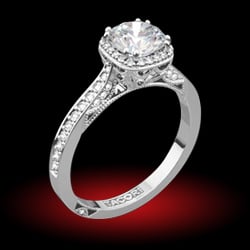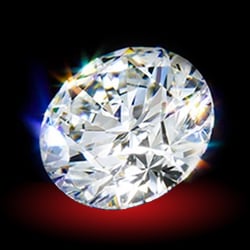Why is it that so many diamonds fall short of the ideal specified size. Check any carat size and the dimensions its supposed to have, and most fall short of this. These are ideal cuts too. The ones with great spread are usually shallower or have very thin girdles or crown angles that aren''t right.
You are using an out of date browser. It may not display this or other websites correctly.
You should upgrade or use an alternative browser.
You should upgrade or use an alternative browser.
So many fall short of ideal size
- Thread starter pinkrose
- Start date
- Status
- Not open for further replies. Please create a new topic or request for this thread to be opened.
- Joined
- Jul 25, 2005
- Messages
- 13,375
http://www.niceice.com/cut.htm may answer some questions.
"Ideal" is a range. "Ideal" has also been subject to change over the years as new technologies emerge. Shallow diamonds do seem to have more tendency toward performance problems and/or durability issues. There are some posts by Pricescope's experts that say in USA, steep/deep stones w/ corresponding smaller diameter are much more comon than spready or shallow stones, and Europeans like the flatter crown style. 58% depth seems to be the number below which performance really suffers.
I apologize for lack of formatting, but I found this someplace, can't recall where. "Ideal" has been slightly different in different places and eras. The last two are the obsolete early 20th century ideals, if I recall.
Benchmark, Crown height, Pavilion depth, Table diameter, Girdle thickness, Crown angle, Pavilion angle
American Standard 16.2% 43.1% 53.0% N/A 34.5° 40.75°
Practical Fine Cut 14.4% 43.2% 56.0% N/A 33.2° 40.8°
Scandinavian Standard 14.6% 43.1% 57.5% N/A 34.5° 40.75°
Eulitz Brilliant 14.45% 43.15% 56.5% 1.5% 33.36° 40.48°
Ideal Brilliant 19.2% 40.0% 56.1% N/A 41.1° 38.7°
Parker Brilliant 10.5% 43.4% 55.9% N/A 25.5° 40.9°
"Ideal" is a range. "Ideal" has also been subject to change over the years as new technologies emerge. Shallow diamonds do seem to have more tendency toward performance problems and/or durability issues. There are some posts by Pricescope's experts that say in USA, steep/deep stones w/ corresponding smaller diameter are much more comon than spready or shallow stones, and Europeans like the flatter crown style. 58% depth seems to be the number below which performance really suffers.
I apologize for lack of formatting, but I found this someplace, can't recall where. "Ideal" has been slightly different in different places and eras. The last two are the obsolete early 20th century ideals, if I recall.
Benchmark, Crown height, Pavilion depth, Table diameter, Girdle thickness, Crown angle, Pavilion angle
American Standard 16.2% 43.1% 53.0% N/A 34.5° 40.75°
Practical Fine Cut 14.4% 43.2% 56.0% N/A 33.2° 40.8°
Scandinavian Standard 14.6% 43.1% 57.5% N/A 34.5° 40.75°
Eulitz Brilliant 14.45% 43.15% 56.5% 1.5% 33.36° 40.48°
Ideal Brilliant 19.2% 40.0% 56.1% N/A 41.1° 38.7°
Parker Brilliant 10.5% 43.4% 55.9% N/A 25.5° 40.9°
Cehrabehra
Super_Ideal_Rock
- Joined
- Jun 29, 2006
- Messages
- 11,071
interesting post! I''d love to get more info/history/insight/comparison on that list you posted.... like what exactly is "american standard" and "ideal brilliant" and "eulitz", and wel the others as well!Date: 10/19/2006 10:23:33 PM
Author: AdaBeta27
http://www.niceice.com/cut.htm may answer some questions.
''Ideal'' is a range. ''Ideal'' has also been subject to change over the years as new technologies emerge. Shallow diamonds do seem to have more tendency toward performance problems and/or durability issues. There are some posts by Pricescope''s experts that say in USA, steep/deep stones w/ corresponding smaller diameter are much more comon than spready or shallow stones, and Europeans like the flatter crown style. 58% depth seems to be the number below which performance really suffers.
I apologize for lack of formatting, but I found this someplace, can''t recall where. ''Ideal'' has been slightly different in different places and eras. The last two are the obsolete early 20th century ideals, if I recall.
Benchmark, Crown height, Pavilion depth, Table diameter, Girdle thickness, Crown angle, Pavilion angle
American Standard 16.2% 43.1% 53.0% N/A 34.5° 40.75°
Practical Fine Cut 14.4% 43.2% 56.0% N/A 33.2° 40.8°
Scandinavian Standard 14.6% 43.1% 57.5% N/A 34.5° 40.75°
Eulitz Brilliant 14.45% 43.15% 56.5% 1.5% 33.36° 40.48°
Ideal Brilliant 19.2% 40.0% 56.1% N/A 41.1° 38.7°
Parker Brilliant 10.5% 43.4% 55.9% N/A 25.5° 40.9°
BMark CrnH PavD Table Girdle CAng PAng
American Standard 16.2% 43.1% 53.0% N/A 34.5° 40.75°
Practical Fine Cut 14.4% 43.2% 56.0% N/A 33.2° 40.8°
Scandinavian Standard 14.6% 43.1% 57.5% N/A 34.5° 40.75°
Eulitz Brilliant 14.45% 43.15% 56.5% 1.5% 33.36° 40.48°
Ideal Brilliant 19.2% 40.0% 56.1% N/A 41.1° 38.7°
Parker Brilliant 10.5% 43.4% 55.9% N/A 25.5° 40.9°
- Joined
- Sep 3, 2000
- Messages
- 6,752
There are many similarities among the "ideal" range suggested by these and other diamond designers over the years. None of them had the benefit of the newest technologies which show us a quite wide range of well performing diamonds which might be classified as "Ideal" or finely cut.
These old statistics do show they were on the right track as no one set of cut characteristics is a sole example of what makes a beautiful diamond. We all know now that a range of characterisitcs leads to the best performance and best looks. Ultimately the selection of what YOU consider most beautiful is of utmost importance anyway. The market value of undeniably best range diamonds will command a premium from those willing to pay it. Others may feel that they can live with a non-premium diamond that looks just fine to their less discerning eyes.
Remember, diamonds come in many shapes before cutting, but the double pyramid is the standard for making round stones. Economics of weight retention lead to certain desirable end results. You don''t cut what you want so much as you cut what works best with that particular piece of rough diamond. You try to maximize value and cut the kind of diamond you feel you are able to sell to your clientele. Not every customer looks for ideal cut range. Far more commercial cut types are sold every day.
The diamond business is a very good example of supply and demand at work. DeBeers has done a good marketing job and a good job at supporting prices based on GIA type grading. The free market does its own good job every day proving itself.
These old statistics do show they were on the right track as no one set of cut characteristics is a sole example of what makes a beautiful diamond. We all know now that a range of characterisitcs leads to the best performance and best looks. Ultimately the selection of what YOU consider most beautiful is of utmost importance anyway. The market value of undeniably best range diamonds will command a premium from those willing to pay it. Others may feel that they can live with a non-premium diamond that looks just fine to their less discerning eyes.
Remember, diamonds come in many shapes before cutting, but the double pyramid is the standard for making round stones. Economics of weight retention lead to certain desirable end results. You don''t cut what you want so much as you cut what works best with that particular piece of rough diamond. You try to maximize value and cut the kind of diamond you feel you are able to sell to your clientele. Not every customer looks for ideal cut range. Far more commercial cut types are sold every day.
The diamond business is a very good example of supply and demand at work. DeBeers has done a good marketing job and a good job at supporting prices based on GIA type grading. The free market does its own good job every day proving itself.
- Status
- Not open for further replies. Please create a new topic or request for this thread to be opened.
Share:
The Ultimate Guide to Men’s Wedding Bands: Metals, Fit & Finish
The Ultimate Guide to Men’s Wedding Bands: Metals, Fit & Finish - 06/27
Chipped Diamonds: Causes, Risks, and What You Should Do About It
Chipped Diamonds: Causes, Risks, and What You Should Do About It - 06/27







300x240.png)